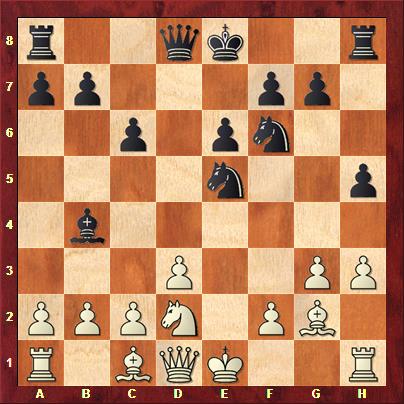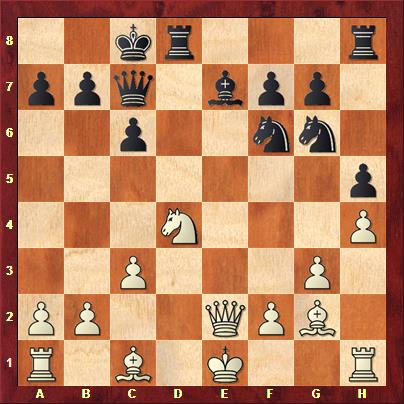


Game five
By the fifth game, the score was still tied up, and while very exciting for spectators around the world, it had to be worrisome for Kasparov that he had failed to impose his authority by now. The loss in game two was not what would cause undue anxiety, since he had lost the first game in the 1996 match, and still came out 4-2 in the end. No, what was worrisome was that the number of obvious positional blunders that had allowed the world champion to push it around so easily, had dropped to a fraction, and it was showing a resourcefulness hitherto unheard of. In spite of the human player's overall better play, in such a short match, any slip could be decisive.
Game five was hardly flawless, and Komodo highlights some mistakes by Deep Blue, and missed opportunities for Garry to better press his advantage. The biggest difference in this particular game is that in one position late in the game, Komodo is able to find a missed winning continuation for Kasparov.
Granted, this is all academic and demanding 'computer precision' from the world champion is unjust, but if true, it is still interesting to note that he had a clearcut chance to swing the balance in his favor.
Position one

It is interesting to remember Garry outraged at Deep Blue's 11...h5,
claiming this as evidence that a human had aided it behind the scenes.
John Nunn:
A surprising move from a computer, but a good one. The computer puts its finger on the slight weakness created by the move h3. This means that after a later ...h4, White will be forced to either defend the g3-pawn or play g4, but then the square f4 is accessible to Black's pieces, especially the knight on g6. Some human players who like pushing their rook's pawns (Speelman, for example) might also have played this move, but it is certainly interesting that Deep Blue finds this quite sophisticated positional idea.
Deep Blue:
As can be seen, 11...h5 was not its first choice, and was a last minute decision as it changed its mind at ply 10.
hash guess nb1d2,Guessing Nd2
7(4) #[O-O](10)################################[h5](18)# 18 T=1
Ph7h5 qd1e2 Qd8d6 pa2a3 Bb4a5 o-o Ba5d2n bc1d2B
8(6) #[h5](-2)##[O-O](0)################################# 0 T=11
O-O o-o Bb4c5 nd2f3 Ne5f3n bg2f3N
9(6) #[O-O](-3)#########<ch> 'nd2'
[153 sec (main.c:1849)][cont]############################ -3 T=39
O-O o-o Bb4d6 nd2b3 Nf6d5 ph3h4 Ph7h6
10(6) #[O-O](-15)######[h5](-5)############################## -5 T=151
Ph7h5 qd1e2 Ne5g6 pc2c3 Bb4e7 nd2e4 Ph5h4 bc1e3 Qd8a5 pg3g4
11(6)[TIMEOUT] -5 T=178
Ph7h5
---------------------------------------
--> 11. .. h5 <-- 29/101:33
---------------------------------------
Komodo 8:
No surprise that Komodo sees the move as a prime candidate, but for the sake of completeness, I checked the other top engines, and it was much the same.
11...h5 12.Qe2 Qc7 13.d4 Bxd2+ 14.Bxd2 Ng6 15.h4 0-0-0 16.Be3 Ng4 17.0-0-0 Nxe3 18.Qxe3 Ne7
+/= (0.33) Depth: 25 00:00:36 163MN
It should be said that after a couple of minutes on a modern desktop, Komodo then prefers 11...Qc7
11...Qc7 12.d4 Nc4 13.c3 Nxd2 14.Bxd2 Be7 15.0-0 0-0 16.Bf4 Bd6 17.Bg5 Be7 18.Qe2 h6 19.Bxf6 Bxf6
+/= (0.34) Depth: 28 00:15:38 4161MN
IBM has several spaces dedicated to Deep Blue, one of its great successes, some recounting the project and history, and also the replayable games with complete notes. The site does not merely include the complete computer moves and analysis, but also all the live commentary made at the time by Maurice Ashley (who was not a GM yet), IM Mike Valvo and GM Yasser Seirawan among others. Sadly these transcripts only cover the early opening phase since after that the live commentary files are blank.
Position two

Though no mention is made of it, Komodo thinks White's choice to
castle queenside was the lesser option, and kingside castling would
have yielded better prospects.
Deep Blue:
In yet another example of how much ahead of its time it was, Deep Blue's mainline coincides with today's top PC programs. It shows it also 0-0, and was not happy about its position (-0.43)
hash guess o-o,Guessing o-o
11(6) #[Bc5](-43)########################################## -43 T=488
Be7c5 bc1e3 Rh8e8 qe2f3 Ng6e5 qf3f5 Qc7d7 bg2h3 Bc5d4n pc3d4B Qd7f5q bh3f5Q
12(6)<ch> 'bg5'
---------------------------------------
--> bc1g5 <--
---------------------------------------
How relevant is this? After White's move it had revised its evaluation to only -0.12
10(6) #[Ng4](-12) T=216
Nf6g4 bg5e7B Qc7e7b qe2e7Q Ng6e7q o-o Ng4f6 pa2a4 Rh8e8 pa4a5 Pa7a6
---------------------------------------
--> 18. .. Ng4 <-- 22/93:19
---------------------------------------
Komodo 8:
18.0-0 Bc5 19.Rd1 Kb8 20.Bg5 Bb6 21.b4 Rhe8 22.Qc2 Ne5 23.a4 a6 24.Rd2 Nc4 25.Bf4 Ne5 26.b5 cxb5
+/= (0.63) Depth: 25 00:05:18 1653MN
Position three

This was without a doubt the turning point in the game. Deep Blue
goes seriously astray, which will lead to a losing position.
John Nunn:
A very odd and mistaken move. Deep Blue was probably attracted to it because it temporarily wins a pawn, but White soon regains it and activates his pieces at the same time.
Deep Blue:
Looking at the logs, we can see that Deep Blue wavered quite a bit between the Qg6, Qd3, Rd7, and even Kc7. It is not a little ironic that the only move Komodo has any major issues with is the one played by its great predecessor.
7(5) #[Qg6](2)########################################[Qd3](9)### 9 T=3
Qd6d3 qc2d3Q Rd8d3q re1e7 Ng4f2p nf3e5 Rd3g3p
8(6) #[Qd3](0)##[Qg6](2)#############[Rd7](3)####################[Kc7](4) 4 T=25
Kb8c7 bg2h3 Pf7f6 pg5g6 Kc7b8 bh3f1
9(6) #[Kc7](-1)#[Rd7](5)#[Qg6](16)###[TIMEOUT] 16 T=195
Qd6g6 qc2g6Q Pf7g6q nf3h4 Nb6c4p re1e7 Ng4f2p re7b7P Kb8c8 pa2a3 Rd8d7 rb7d7R Kc8d7r nh4g6P Nf2d1
---------------------------------------
--> 29. .. Qg6 <-- 11/63:16
---------------------------------------
Komodo 8:
As to what Komodo would choose itself:
29...Rd7 30.b3 Nc8 31.Re2 Ne7 32.Nd2 f5 33.gxf6 Nxf6 34.Kb2 h4 35.gxh4 Qh2 36.Be4 Qe5+ 37.Kb1 Qf4
= (0.10) Depth: 27 00:03:27 1252MN
Position four

This is the key juncture in the game. Garry had made the most of
the computer's mistake, and reached this position. Unfortunately
he missed the most precise continuation, and Deep Blue saved it.
John Nunn:
"It seems to me that the diagram position is critical for the assessment of the ending. After the move played Deep Blue manages to forced a draw by means of a surprising tactical manoeuvre. The alternative was to play a rook move, delaying Nf4 in the hope of restricting Black's options."
The gandmaster's judgement is faultless, and he correctly senses this position is key. He only misses the exact continuation to compound White's advantage.
Deep Blue:
To be fair, Deep Blue did not fare any better, and expected 44.Nf6
hash guess nh5f6,Guessing Nf6
-----------------------------------
-----------------------------------
12(6) #[Nxb3](-5)##################### -5 T=265
Nd2b3p kc1b1 Ra2g2 nf6d5 Kc7d7 rg6g7 Kd7d6 nd5e3 Rg2g1 kb1b2 Nb3d4 pg3g4 Nd4b5p rg7b7P Rg1e1 ne3f5 Kd6c6 rb7e7
13(7)<ch> 'nf4'
---------------------------------------
--> nh5f4 <--
---------------------------------------
Komodo 8:
Komodo's evaluation was quite different for 44.Rg7+ as can be seen.
44.Rg7+ Kd6 45.Rxb7 Nxb3+ 46.Kb1 Rh2 47.Nf6 Nd2+ 48.Kc1 Nb3+ 49.Kd1 Rh1+ 50.Ke2 Nd4+ 51.Kf2 Ke6 52.g6 Kxf6 53.g7
+/- (1.17) Depth: 27 00:03:39 1921MN
In order to see where this led, the continuation was analyzed quite extensively with the engine and all lines led to winning positions. The analysis of the position and the computer's evaluations can be replayed below.

Game six is a well-documented opening horror story. Garry Kasparov blundered on move seven and then again on move eight, and he could just as easily have resigned there and then. The speculations and conspiracy theories are legion as to what happened, and there is really little to look at.
Comparing Deep Blue's moves and output, one can see it had progressed enormously since the 1996 match from the year before. It seems pretty clear that while Kasparov was overall superior to Deep Blue from a theoretical point of view, it was no longer the towering advantage he had in previous encounters, and even by today's standards, Deep Blue played very few serious mistakes.
If it really played few outright blunders, how is it that a modern engine such as Komodo is so superior? Chess is more than dropping a piece or a pawn, it is the accumulation of small and sometimes minute evaluation differences that lead to change in the course of the game. This accumulation of small advantages can and will add up to a large and decisive one in the end, and if you have any doubts, ask Carlsen's opponents today.
It should be pointed out that Deep Blue's hardware with the supercomputer running it, and the specialized chips designed to play chess, would still trump a desktop PC in plain computing power. One need only remember the 200 million positions per second, a figure that is hard to get around. Where Deep Blue fails is in pure software strength, in which it is trumped by nearly two decades of chess programming techniques, algorithms, and tuning methods.

The epic matches between Garry Kasparov and Deep Blue are now a part of modern folklore, and continue to stir the imagination to this day. Here is a scene from "The Machine", a theatrical production Off-Broadway with Hadley Fraser and Kenneth Lee (photo by Stephanie Berger)
As to Kasparov losing to it in spite of a perfectly understandable belief that he was still the stronger of the two then, it should be pointed out that it was really a matter of time. At the rate it was progressing, comparing Deep Blue from 1996 to 1997, if the world champion had come out on top in the rematch, then he might have fallen in 1998, or 1999, but the question was not a matter of if but when. Ultimately, if the very best humanity has to offer is going to lose to a machine, then let it be the most expensive, most powerful chess machine ever built.
The power of Deep Blue for your own personal pleasure? Today, you have it and more in a top engine such as Komodo, whether on your desktop, laptop, or smartphone. The future has arrived.

Minimum: Pentium III 1 GHz, 2 GB RAM, Windows Vista, XP (Service Pack 3), 7/8, DirectX9, 256 MB graphics card, DVD-ROM drive, Windows Media Player 9 and Internet access for program activation, access to Playchess.com, Let’s Check and program updates.
Recommended: PC Intel i7 (Quadcore), 4 GB RAM, Windows 8.1, DirectX10, 512 MB graphics card, 100% DirectX10-compatible sound card, Windows Media Player 11, DVD-ROM drive and Internet access for program activation, access to Playchess.com, Let's Check and program updates.
Price: €79.90 (€67.14 without VAT for customers outside the EU; $86.62 without VAT). Languages: English, German. ISBN: 978-3-86681-442-4; EAN: 9783866814424. Delivery: Download, Post
Order Komodo Chess 8 in the ChessBase shop now!